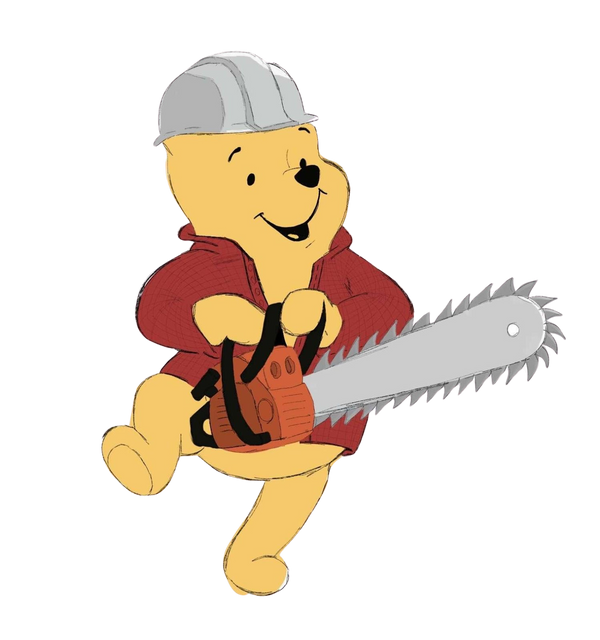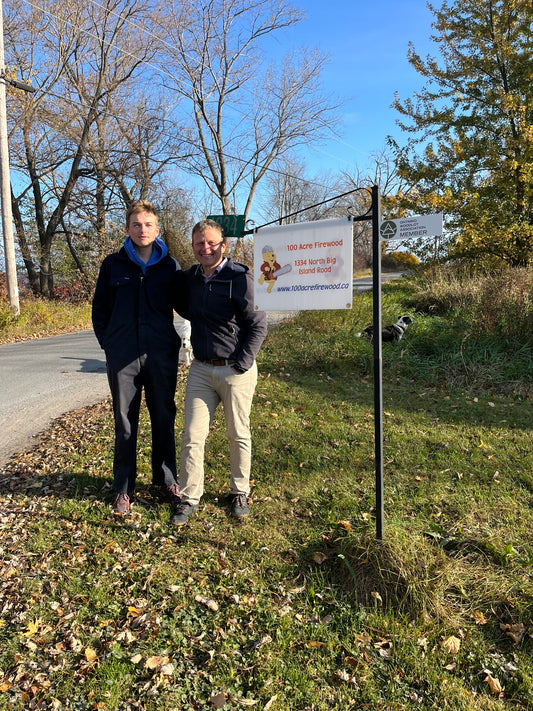At 100 Acre Firewood we are constantly cutting down trees for firewood and are left with the unsightly mess left of behind. Tons of branches, twigs and wood pieces too small for customer use. We wanted to do something more creative and better for the environment then just burning up these leftover with a bonfire. About a year ago - as an anniversary present to my understanding wife Angela - we purchased a Wallenstein BXT 4224 Woodchipper off of Kijiji. What a game changer this anniversary present has been... In this blog post, we will explore how you can use a wood chipper to clean up the debris from firewood trees and repurpose the chips to create stunning walking paths.
What is a wood chipper and how does it work?
A wood chipper is a powerful machine designed to break down branches, twigs, and other woody debris into small, manageable chips. It consists of a hopper where you feed the branches, a set of sharp blades that shred the wood, and a discharge chute that expels the chips. We blow the chips directly into our Club Car XRT 1550 - if has a dump box that makes adding the chips to our paths pretty easy.
Step 1: Gather the branches
Before you can start chipping, you need to gather the branches and other debris from your firewood trees. Make sure to remove any leaves or small twigs that may clog the wood chipper. Usually we do this at the same time as we are harvesting firewood trees. We set aside the branches suitable for chipping - when trimming these branches off anything under 4 inches is used to create chips.
Step 2: Set up the wood chipper
Find a suitable location for your wood chipper. It should be on a level surface and away from any obstacles or bystanders. Follow the manufacturer's instructions to properly set up the machine, including connecting it to a power source if necessary. We setup the woodchipper in a central location close to where we are harvesting trees and have piles of wood chipper ready material. The woodchipper is typically hooked to the back of our XRT 1550 golf cart so that we can easily move it around the work area.
Step 3: Feed the branches into the hopper
Take one branch at a time and feed it into the hopper of the wood chipper. Make sure to keep your hands and loose clothing away from the blades to avoid any accidents. Let the machine do the work as it pulls in the branches and shreds them into chips. With the Wallenstein BXT 4224 you need push some of the branches through the machine because there is no auto feeder - it moves through quickly with a light push. Longer straight run branches feed through the best - it is a good idea to prep the branches like this to make the chipping process faster. Teamwork is a GREAT idea in this step - one person feeds the chipper - one person preps the branches for feeder and one person is bringing branches that are further away.(This is where it is great to have 3 sons to help you out!)
Step 4: Collect the wood chips
As the wood chipper discharges the chips through the chute, we collect them directly into our XRT 1550. The dump box on the XRT makes unloading a very easy process. The woodchipper discharges the chips in a directional fashion but there are a lot that undershoot or overshoot the box - one of these fine days I am going to build some diverters that will make sure that we do not waste wood chips.
Step 5: Prepare the walking path
Once you have a sufficient amount of wood chips, it's time to prepare the walking path. Clear the area of any vegetation or debris, and level the ground if necessary - a lot of the time you can use the chips themselves to level out the path if it is uneven. You can outline the path using stones, bricks, or other materials to create a defined border. We have too many kilometers of trails to mess around with a border but I could see adding borders closer to the house for a nice effect.
Step 6: Spread the wood chips
Spread a layer of wood chips evenly along the walking path. Aim for a thickness of about 2 to 3 inches. Use a rake or shovel to distribute the chips and ensure a smooth surface. If needed, add more chips to achieve the desired thickness. After spreading the chips we usually run over the path with our Bobcat T76 to compress the chips and help level them out some more. Our paths are pretty roughly done due to length - over time we will trim them up we firewood processing slows down.
Step 7: Maintain the walking path
Over time, the wood chips may decompose and compact. To maintain the walking path, periodically add fresh wood chips and rake them to even out the surface. This will help prevent weed growth and ensure a safe and attractive walking area.
By using a wood chipper to clean up the leftover branches from firewood trees and repurposing the chips for walking paths, you not only eliminate waste but also create a beautiful and sustainable landscape feature. So, why not give it a try and transform your firewood debris into a functional and visually appealing walking path?




